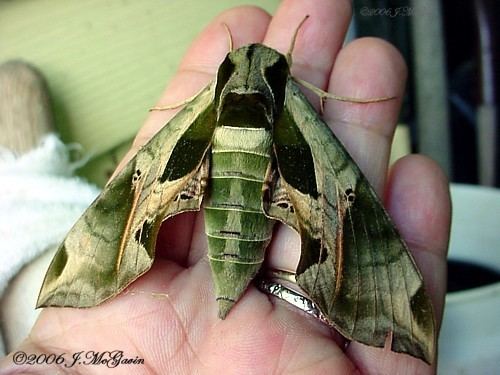Class Insecta | Phylum Arthropoda Genus Eumorpha Rank Species | |
 | ||
Similar Eumorpha, Eumorpha achemon, Darapsa, Hemaris diffinis, Ceratomia amyntor | ||
Pandora sphinx moth eumorpha pandorus caterpillar big ass caterpillar stabilized version
The Pandora sphinx moth (Eumorpha pandorus), also called the pandorus sphinx moth, is a North American moth in the family Sphingidae. It is a large, greenish gray moth with darker patches and pink edges and small pink eyespots. The underside is usually pale yellow-green or brown. It has a wingspan of 3¼–4½ inches (8.2–11.5 cm), females being slightly larger than males. Pandora sphinx moths fly during dusk. Some places see only one generation a year, while others see two.
Contents
- Pandora sphinx moth eumorpha pandorus caterpillar big ass caterpillar stabilized version
- Pandora sphinx moth eumorpha pandorus
- Life cycle
- References

Pandora sphinx moth eumorpha pandorus
Life cycle

Female adults lay translucent eggs singly on leaves of the host plant, mainly Vitis (grapes), and Parthenocissus (Virginia creeper). Caterpillars are large, green or red with a swollen third thorax segment into which the head and first two thoractic segments can be drawn. The abdomen has a small white spot on the second segment, and big white oval spots the last five spiracles. They also have the characteristic "horn" at the end of the abdomen, until it is replaced by a button in its last instar. Larvae consume copious amounts of foliage, and when they are ready they climb down their host plant and burrow underground, where they pupate. The pupa is dark brown in color, quite slender, and has a long cremaster. There the pupa will remain for either a couple of weeks or a couple of months, depending on the generation. When the pupa is ready, it wiggles to the surface just prior to eclosion. The newly emerged adults then climb on a plant or some other surface, and pump fluid into their wings to extend them. Females emit pheromones at night, and males fly into the wind to pick up and track the pheromone plume.

